I’ve worked with hundreds of divorcing couples on post-divorce budgeting, and I can tell you that this is where the rubber meets the road. You can negotiate the best spousal support agreement in the world, but if you don’t understand how to budget and manage your money after divorce, you’re going to struggle. Especially in a high-cost-of-living state like California! Let me walk you through how to create a realistic budget that allows you to move forward successfully.
The harsh math of divorce
Let’s start with the reality I’ve mentioned throughout these articles: one household is becoming two households. During your marriage, you shared housing costs, utilities, insurance, streaming services, and countless other expenses. After a divorce, you each need your own place with separate expenses for everything.
The exact total household income that supported one family now has to stretch to support two separate households. Even with spousal support helping to balance the incomes, there’s less money available per person than when you were sharing everything. Most divorcing couples experience a decrease in their standard of living, at least initially. Understanding and accepting this reality is the first step toward successful budgeting.
This doesn’t mean you’ll be destitute. It means you need to be realistic about what your post-divorce lifestyle can look like and plan accordingly.

Start with an honest assessment of your current spending
Before you can create a post-divorce budget, you need to understand your marital spending patterns. Pull your bank statements, credit card statements, and any other financial records for the past six to twelve months. Look at where the money actually went, not where you think it went or where it should have gone.
In mediation, I help couples work through this analysis together. We categorize expenses into major buckets like housing, transportation, food, insurance, healthcare, childcare, entertainment, and discretionary spending. This gives us a baseline understanding of your marital standard of living—what you actually spent to maintain your lifestyle during the marriage.
This historical data is important because it grounds your post-divorce budget in reality. Maybe you think you can live on $4,000 per month, but when we look at actual spending, your share of marital expenses was closer to $6,000. That gap between perception and reality needs to be addressed.
Building your post-divorce budget: the receiving spouse
If you’ll be receiving spousal support, your post-divorce budget needs to account for all your income sources – your own earnings, the spousal support you’ll receive, any child support if applicable, and any other income. Then list all your expenses.
Start with your fixed expenses—the ones that don’t change month to month. Your rent or mortgage, car payment, insurance premiums, HOA fees if applicable, loan payments, and any other recurring obligations. These are your non-negotiables that must be paid.
Next, look at your variable but necessary expenses. Utilities, groceries, gas, phone, internet, and healthcare costs that aren’t covered by insurance. These will fluctuate somewhat, but are essential expenses.
Then comes the more challenging part – discretionary spending. Entertainment, dining out, travel, hobbies, clothing beyond basics, and all the other things that make life enjoyable but aren’t strictly necessary. This is where you’ll likely need to make adjustments to your marital spending.
Here’s the critical question for receiving spouses: can you cover all your reasonable expenses with the support you’ll receive plus your own income? If the answer is no, you need to either increase your income, decrease your expenses, or negotiate different spousal support terms. Hoping it will somehow work out is not a plan.
Building your post-divorce budget: the paying spouse
If you’ll be paying spousal support, your budgeting starts with accepting that a significant portion of your income is going to your ex-spouse. That money isn’t available for your expenses. Your budget needs to work with what remains after you’ve paid support and any child support obligations.
Start by calculating your net income after all taxes and mandatory deductions. Then subtract your support obligations—both spousal and child support, if applicable. What’s left is what you have to live on.
Now go through the same expense analysis – fixed costs, variable necessities, and discretionary spending. Can you cover your reasonable expenses with what remains? If not, where can you cut? What lifestyle adjustments do you need to make?
Many paying spouses discover they need to downsize their lifestyle significantly. Maybe you can’t afford to keep the lovely apartment and need to find something more modest. Maybe you can’t afford your current car payment and need to trade down. Maybe dining out several times a week isn’t realistic anymore. These realizations are harsh but necessary.
Distinguishing needs from wants
This is where my financial background really helps couples in mediation. We need to distinguish between needs and wants, between essential expenses and discretionary spending. You need housing, but do you need a three-bedroom apartment or will a two-bedroom work? You need transportation, but do you need a new car with a $900 payment, or can you drive a reliable used car?
California has a high cost of living, which makes this analysis challenging. Housing alone can consume a considerable percentage of your budget. But even in California, there are choices to be made about where you live, what amenities you require, and how you allocate your limited resources.
Needs include safe housing in a reasonable area, reliable transportation, adequate food, necessary healthcare, appropriate clothing, and essential utilities. Wants include upgrades, luxuries, entertainment, travel, and lifestyle enhancements beyond necessities.
In mediation, we work through these categories honestly. I’m not here to judge your spending or tell you what you should value. But I do help you see clearly where your money is going and whether your proposed budget is realistic given your income and support obligations.

Planning for when support ends
If you’re receiving spousal support, you need to plan for the day when those payments stop. Support doesn’t last forever—we’ve discussed the duration extensively. What will your financial situation look like when support ends? Can you cover your expenses with your own income at that point?
This is why the path to self-sufficiency is so essential. Your post-divorce budget should include investments in yourself—education, training, and career development—that will increase your earning capacity over time. You shouldn’t be planning to live on support indefinitely. You should be planning to transition to self-sufficiency by the time support ends.
Build this into your budget. Maybe that means setting aside time and money for coursework or certification programs. Maybe it means gradually increasing your work hours as your children get older. Maybe it means strategic career moves that position you for higher income. Whatever your path to self-sufficiency, it should be reflected in your financial planning.
The emotional side of budgeting after divorce
Let’s acknowledge that adjusting to a post-divorce budget isn’t just a math problem—it’s an emotional challenge. You may be grieving the lifestyle you’re losing. You may be angry about the financial impact of divorce. You may feel anxious about making ends meet.
These feelings are valid, but they can’t drive your financial decisions. You need to separate the emotional processing of divorce from the practical reality of budgeting. Yes, it’s not fair that you have to downsize. Yes, it’s frustrating that your income doesn’t go as far as you’d like. But your budget needs to be based on reality, not wishful thinking or anger.
In mediation, I help couples work through the emotional aspects of financial adjustment while keeping the focus on practical planning. We acknowledge the difficulty while still doing the work necessary to create workable budgets.
Why having a mediator with financial expertise matters
This is where my MBA in Finance and training from the Institute for Divorce Financial Analysis really provide value. Budgeting after divorce isn’t just about listing income and expenses – it’s about financial planning, cash flow analysis, understanding tax implications, and strategic thinking about your financial future.
I can help you analyze whether your proposed budget is realistic. I can identify areas where you might be under-budgeting for actual costs. I can help you think through timing and cash flow issues. I can suggest strategies for building toward self-sufficiency or managing support obligations efficiently.
Most importantly, I can help both spouses understand each other’s post-divorce financial reality. When the paying spouse sees the supported spouse’s detailed budget and understands their actual needs, it creates empathy. When the receiving spouse sees what the paying spouse has left to live on after support, it creates perspective. This mutual understanding leads to fairer agreements.
Your path forward financially
Budgeting for life after divorce when spousal support is involved requires honest assessment, realistic planning, and a willingness to adjust your expectations. Both paying and receiving spouses face financial challenges. Both need to plan carefully and manage money wisely.
In mediation, we work through this budgeting process together. We look at the real numbers. We discuss what’s realistic and what’s not. We create a support arrangement that fits within workable budgets for both spouses. And we help you think through not just the immediate post-divorce period but the longer-term path toward financial stability.
Your post-divorce budget won’t look like your married budget. But with careful planning and realistic expectations, it can support a good life—different from before, but still good. That’s what smart budgeting after divorce makes possible.






